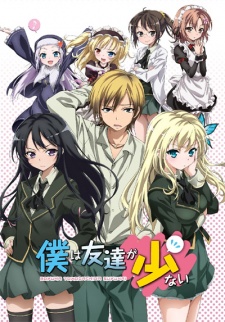
There is an inherent irony at play in Boku wa Tomodachi ga Sukunai (which will henceforth be referred to by its alternate title, Haganai), in that the characters band together in an attempt to learn how to make friends, without ever acknowledging that they have made friends with each other. In fact, there are a few key scenes, especially towards the end, that indicate they are actively not regarding each other as friends. All the other ingredients of a slice of life are there. Everyone meets one another by joining a club, where they find new ways to enjoy their high school life together. Each of them has some defining characteristic that separates them from one another, and unfortunately from any real human high school student. These differences create unique interactions between the different pairs of characters, some more pronounced than others. In some sense no new ground is tread. But all the while there is an underlying theme of not being friends that laughs at these ingredients, even when most of the show plays out like a normal slice of life that disregards that theme entirely.
As stated, there is little need to explain the central details of the show. Due to his natural blond hair color and a series of unfortunate interactions, Kodaka, the protagonist, is mistaken for a delinquent as he transfers into a new school, and thus quickly finds himself without any friends. One month into school, he catches a girl in his class named Yozora talking to an imaginary friend. Quickly they establish that neither has any friends, at which point Yozora decides to create a club based around the idea of learning how to make friends. The club grows quickly to include seven people, namely a popular, rich, perfect girl named Sena who constantly fights with Yozora. These two girls also seem to have crushes on Kodaka, but thankfully Haganai spares us from the usual antics of completely obvious romantic ploys being brushed aside by the dense protagonist, and instead only gives us very slight hints of this insufferable trope.
There is clear ridiculous comedy that comes from the idea of a club filled with friendless high schoolers, from avoiding crowds of people to discovering the world of visual novels. A clear winner to me was when they all go to the beach and spend a good 10 minutes trying to decipher the meaning of the classic image of students jumping in various poses in sync, shouting “It’s the beach!” Obviously there are no actual people who would do this, but to anyone who has watched more than a few slice of life anime, there is a staple use of beach episodes with this shot. So having these misguided students deciding why and how to perform this jump can be interpreted as a meta joke Haganai plays against its own genre, or even better, that the characters use slice of life to emulate realism and ending up as a parody of it instead. The idea that these shut-ins all watch anime and cannot distinguish how ridiculous it would be to jump at the same time in a line without any prompt is a jab at both itself and the audience watching it.
And yet for this seeming awareness it promptly falls into the trap of committing most of the later episodes to drama, pretending to have a profound emotional depth. This ultimately fails to be evocative precisely because the characters do each stand out in unique and extreme ways, which makes them less memorable and less relatable. This does not go out to the extreme that many shows do, and their choices of characteristics are quite fun, but nevertheless I find that the characters do little for the show as a whole, and so they really work much better when their characters are being played for laughs. The interactions that occur based around concepts of their friendship and denial, however, stand out quite a bit as examples of good writing and a clear message being portrayed using the central theme. While obviously not as comedic, these moments are what escalate the show beyond the mean.
Normally the characters and jokes would be fairly standard, but Haganai shows that when a work chooses its setting well and commits to grounding its comedy in that setting, even average characters and jokes are enough to provide plenty of enjoyment. A mark of a good comedy to me is that I would open up a random episode to kill a half hour, but while I wouldn’t go quite that far for Haganai it is only because I feel that this extra level would be lost, and it would be fairly unmemorable. As a marathon though, there are twelve episodes of laughs waiting to happen.